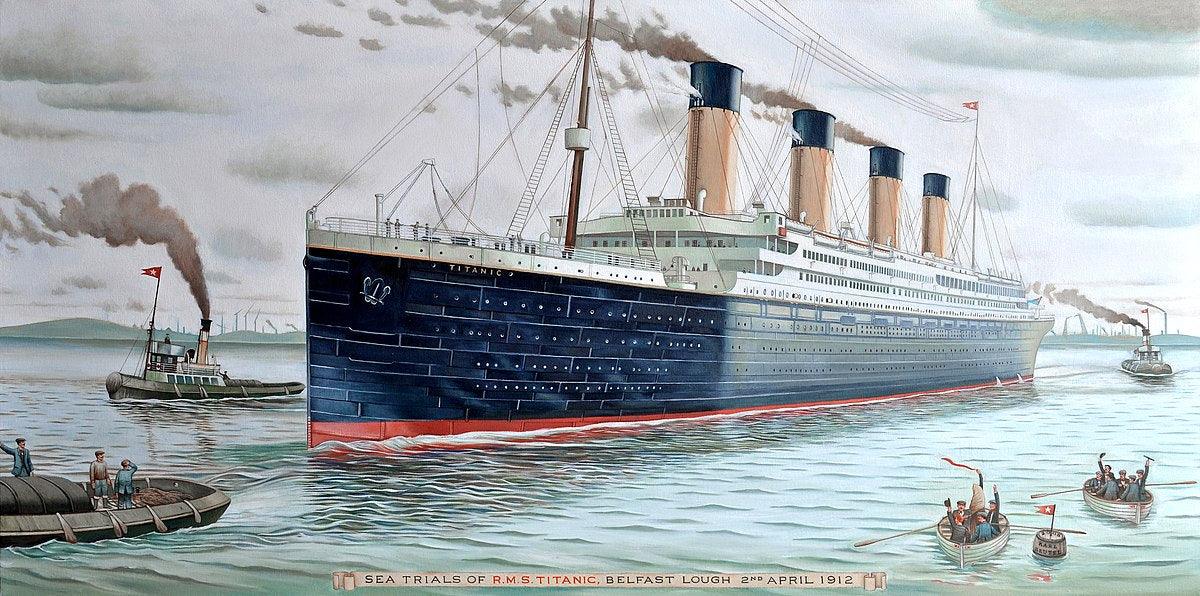
Oh the Jewels that Were Lost: the 110th Anniversary of Titanic Sinking.
(Image courtesy of Wiki Commons)
RMS Titanic was the ultimate ship of dreams in 1912 when it launched on its maiden and final voyage. It was the dream of its owners, designers and builders; the dream voyage for the upper class sailing to america in the greatest luxury then available on the ocean; and for many of the second and third class passengers, not only luxury available to them for the first time in their lives, but a dream of a new life, as hundred upon hundreds crammed the ships third class bays to emigrate to america.
That dream was shattered when it struck an iceberg 110 years ago this morning; and the great titan of a ship, and most of its passengers, sank to a dark, cold, watery grave.
Over 1,500 souls out of the ships estimated 2300 were lost in the tragedy, who’s preventable nature spurred the adoption of major maritime policy changes, including the creation of the Convention for the Safety of Life at Sea (SOLAS).
While the loss of life is the tragedy of this event, more than lives were lost. From the claims made after the sinking to insurance companies, and in auctions of those remaining and recovered items today, it is estimated that about $200 million worth of precious assets were lost in the disaster.
In her insurance claim for losses, Margaret Brown, later nicknamed “the unsinkable Molly Brown,” included a claim of $20,000 for a single necklace. Today, that would be almost $600,000!
Amazingly, over 5500 artifacts of value have been recovered from the wreck site. One of the most famous items is one of the bronze cherubs that graced staircases in titanic, and possibly one from the bottom of the grand staircase in first class- that's the famous staircase in the movie. (Image courtesy of Wiki Commons)

Also found: a pocket watch stopped at 2:28, very close to the exact time the ship sank, and numerous precious stones, jewels and pieces of jewelry recovered in 1987 in a leather satchel recovered from the wreck site. However, contrary to legend, most of the jewels aboard went with their owners, into a lifeboat, or to the dark, icy deep, and did not remain in supposed lock-boxes and safes.
One piece in particular, and its story, would become the inspiration for the most memorable retelling of that sad story.
In 1997, the movie Titanic, by James Cameron, introduced the world to the fictional characters of Rose and Jack and Cal, and arguably, “La Coeur de la Mar,” “The Heart of the Sea,” a diamond necklace featuring a massive blue diamond surrounded by an ocean of gleaming white diamonds.

(Image courtesy of Flickr)
While “The Heart of the Ocean,” was fictional, a real diamond and sapphire necklace was on the Titanic. This necklace was quite different from the fictional “La Coeur de la Mar” blue diamond necklace in the movie. Instead of a fat pear shape with indent (not a true heart as many of the replicas are) the now named “Love of the Sea,” is a large blue emerald cut sapphire set in yellow gold with diamond pave, and filigree and milgrain detailing. It survived the sinking and inspired part of the “Heart of the Ocean’s” place in the plot.
The “Love of the Sea” started its own Titanic story when it was bought by Henry Samuel Morley, a confectioner, who ran away from his family to board the fated ship with Kate Florence Phillips, the woman who he had begun an affair with some time previously.
No doubt Kate and Henry believed they were leaving their troubles behind them.
When the ship began sinking, Henry hurried Kate, dressed in little more than a nightgown, to a lifeboat. He put the pendant around her neck before seeing her to safety. Kate spent the next terrifying hours in lifeboat #11, shivering in scant clothing and the magnificent gem, much as Rose does. Unfortunately for Kate, like Rose with Jack, Henry would perish in the freezing ocean that tragic night- he could not swim.
The sapphire pendant which survived with Kate was bequeathed to her daughter after her death, and has gone on exhibition at various times.
For the movie, a model was made of the fictional necklace using cubic zirconia and white gold, and is now kept in the production house’s vaults. It was designed based on another famous blue diamond, the Blue Heart diamond, which was designed and set by Harry Winston with a halo of brilliant white diamonds, and weighs about 30 carats, now on display at the Smithsonian. If “The Heart of the Ocean” had been a real, 56 carat Blue Diamond, it would have been valued at about 350 million dollars, however it took less than $10,000 to produce the mock version for the movie. Noting that a somewhat real version ought to be available, and with no blue diamonds of that size apparently available or affordable for the post production ($350 million may have been out of budget, possibly…) a replica was made later by Asprey & Garrad, with a whopping 171 carat, sapphire center stone, which Celine Dion wore to the 1998 Oscars, It was sold at auction for $1.4 million.



